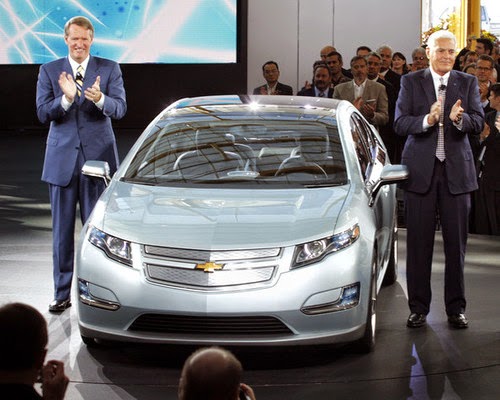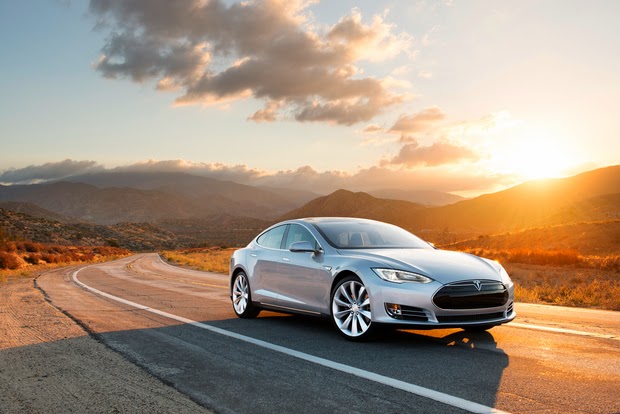In the 2011 State of the Union Address, President Obama boasted that we’d have 1 million electric cars on the road by 2015. As I noted in my last post, it’s 2015 and we’re nowhere near that goal. What happened?
I think Obama over-reached … but there is this little matter of a 2012 Dept of Energy report saying the manufacturing capacity was there to produce the EV’s needed to reach the goal![]() .
.
The DoE report suggested that by 2012 GM would be selling 100,000 Volt’s a year, Nissan selling a similar number of Leaf’s a year, and there would be some other vehicles on the market as well. If that woulda happened, we’d be a lot closer to 1 million BEV’s and PHEV’s on the road, than the 280,000 estimated to have been sold in the U.S. so far.
Sales of the Chevy Volt are shrinking, with lots fewer sold in 2014 than in 2013. I (and others) have noted that GM’s marketing of the Volt is an abysmal failure. Between that and the Spark-EV-compliance-car and Cadillac ELR both selling in minuscule quantities, one has to wonder if GM is at all interested in any kind of leadership position in electric vehicles.
The Volt did see a lot of political backlash in 2011-12 – being made into a Presidential Politics football. It’s a good car and doesn’t deserve this treatment. Then there was the matter of the single Volt car fire following a crash test, which became part of that political firestorm.
At the time neither issue seemed to affect Volt sales – they increased from 2012 to 2013. Whatever caused the falloff occurred after 2013. Maybe it’s expectation of the Volt2 that dried up interest? Or relative price benefit of the all-electric Leaf? At a 20,000 Volt’s per year the sales rate is a far cry from the 65,000 per year former GM CEO Dan Akerson predicted, or the 100,000 per year predicted by the DoE.
The Nissan Leaf is in a different situation, having steadily growing sales figures. There was a stumble in 2011 when, in the aftermath of the Fukushima earthquake and nuclear plant meltdown, Nissan had trouble building Leaf’s and keeping up with worldwide demand. In 2013 the company not only revamped the Leaf, giving it some much-needed improvements, they also began manufacturing operations in both Europe and Tennessee. That gave a price advantage allowing Nissan to offer the Leaf at reasonable prices.
But the 30,000+ per year sales rate isn’t enough to have reached a 1 million total this year, or any time soon.
Of the other automakers, only Tesla (Model S) and BMW (i3) are selling a significant number of electric vehicles. The Model S was delayed from its initial launch date, and the company is pushing for sales in countries around the world rather than solely in the U.S. BMW is taking great strides with the BMW i3, though it just began deliveries in early 2014. We should look to this car to increase the total rate of EV sales.
Getting back to the question at the top – Why are we such a long ways off from the 1 million EV goal?
On one hand it’s clear the automakers weren’t all as enthusiastic about that goal as President Obama. Tesla and Nissan are on board, but can we say this about the others?
The automakers can’t sell cars if the customers aren’t there. As I noted the other day, car buyers have high expectations for electric vehicles, and the current crop of cars don’t meet those expectations. Only Tesla Motors delivers an electric car with the range and charging speed desired by car buyers, but at a price few people can afford. In a way it’s surprising that Tesla’s cars are selling so well given the limited market because of their price.
If we think back to the uptake of the Toyota Prius – it’s now a highly popular car, but that wasn’t true for the first generation Prius. It wasn’t until Toyota unveiled the GenII Prius that sales took off.
The same could well be happening in the BEV and PHEV market. The current crop of cars are still the first generation, and the second generation vehicles aren’t due until 2016-17-18. The second generation should have the 200ish mile driving range and fast charging to satisfy car buyer expectations.
At the same time, Obama is no longer pounding his chest about electric vehicles and green technology like he’d done in 2009-10. Instead, the last couple years he’s been boasting about oil production increases coming from fracking.
- Highway design could decrease death and injury risk, if “we” chose smarter designs - March 28, 2015
- GM really did trademark “range anxiety”, only later to abandon that mark - March 25, 2015
- US Government releases new regulations on hydraulic fracturing, that some call “toothless” - March 20, 2015
- Tesla Motors magic pill to solve range anxiety doesn’t quite instill range confidence - March 19, 2015
- Update on Galena IL oil train – 21 cars involved, which were the supposedly safer CP1232 design - March 7, 2015
- Another oil bomb train – why are they shipping crude oil by train? – Symptoms of fossil fuel addiction - March 6, 2015
- Chevron relinquishes fracking in Romania, as part of broader pull-out from Eastern European fracking operations - February 22, 2015
- Answer anti- electric car articles with truth and pride – truth outshines all distortions - February 19, 2015
- Apple taking big risk on developing a car? Please, Apple, don’t go there! - February 16, 2015
- Toyota, Nissan, Honda working on Japanese fuel cell infrastructure for Japanese government - February 12, 2015


















